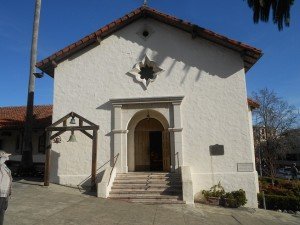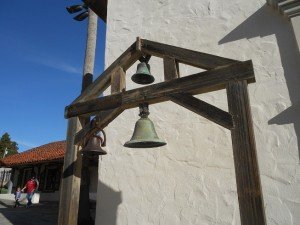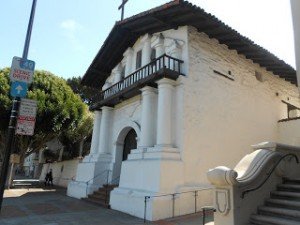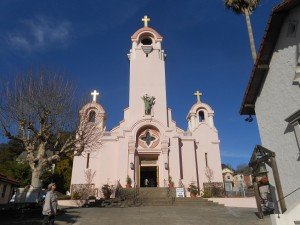One of the most interesting stories pertaining to the old Spanish Missions of California regards Mission San Rafael Arcangel in San Rafael California. This is a very convenient mission to visit being located just about twenty miles north of San Francisco along U.S. Hwy 101.

If your vacation plans include San Francisco, make certain to head north over the Golden Gate and visit historic San Rafael.
Mission San Rafael Arcangel Replica
The original mission replica you’ll explore today, the one dedicated in 1949, was built according to original specifications known at the time.
There were no photos of the original structure therefore the replica was built based on what was known with some variations. The small church building faces west whereas the original faced east. The site location is next to the St. Raphael Parish of the Archdiocese of San Francisco. The replica site is approximate since other church buildings had been built adjacent prior to 1949.
Today’s visitor will notice that the old mission replica is in no way adorned as are most all other California missions. This was because, as mentioned above, Mission San Rafael Arcangel was not originally planned to become an official stand alone mission. Built as a branch of Mission Dolores, the church building was a fairly plain unadorned structure.

The Problems at Mission Dolores
The realities at Mission Dolores in San Francisco were such it’s believed that 5,000 Native Americans were buried at the mission cemetery. Disease ran rampant at the mission site and as was the case with much contact between Europeans and Native Americans, the Indians were easily affected by European bred diseases. This phenomena began from the very first contact between Native American and European. This problem continued into the 1800’s all across the western frontier.
A Change of Climate
The site of Mission San Rafael Arcangel was chosen for a reason. The area which in present day San Rafael California had much more sunshine and much less fog than the San Francisco peninsula to the south.

The mountains to the west of San Rafael acted as a buffer to the weather coming off the Pacific Ocean. The regular fog and damp conditions caused illness. The San Francisco peninsula lacked the natural barrier that San Rafael enjoyed.. The added sunshine and generally milder weather was sought to help the healing process. The move to establish the mission in San Rafael seemed to work quite well. Ailing Native Americans seemed to recover very well at this new more sunny and mild location.
Visiting Mission San Rafael Arcangel
A day trip north of the Golden Gate Bridge to Mission San Rafael Arcangel is an excellent addition to a Bay Area trip planner. The story of the Spanish Missions is really a vivid story of the very beginnings of California settlement. There’s much to learn visiting any of the old missions and Mission San Rafael Arcangel tells us a very unique part of that story.

From San Francisco, drive north on U.S. Highway 101 from the Golden Gate Bridge about fifteen miles and exit at Central San Rafael (Exit 452). The mission is located at 1104 Fifth Avenue about four blocks west of the freeway.
Driving to San Rafael from the east bay area allows you to cross the bay via the Richmond/San Rafael Bridge. After you merge onto U.S. Hwy 101 northbound take exit 452 as described above.
See the Trips Into History articles on the links below…
The Last Days of the California Stagecoach
World War Two Attacks on the West Coast
California and the Old Spanish Missions

For those making a trip to the Sonoma wine country from San Francisco can easily visit both Mission San Rafael Arcangel and the Sonoma Mission in Sonoma California during a day trip. Mission Sonoma (Mission San Francisco Solano) was the last of the twenty-one missions built and was actually constructed by the Mexican government after their ouster of the Spaniards.
The Mission Sonoma is located in the heart of Sonoma California, between the cities of Napa and Santa Rosa off State Hwy 12.
The town of Sonoma is also in the heart of the beautiful Sonoma Valley wine country which this area north of San Francisco Bay is so noted for. It’s also adjacent to the popular Napa Valley wine country. The old Spanish mission and the entire town of Sonoma is part of the Sonoma State Historic Park.
Parts of Sonoma State Historic Park include the Mission San Francisco Solano, the Blue Wing Inn, Sonoma Barracks, the Toscano Hotel, the Servants Quarters Vallejo’s Home. Visitors typically walk through the streets surrounding Sonoma’s historic central plaza. Maps are available at the Sonoma Visitors Center.
(Article and photos copyright 2014 Trips Into History)
